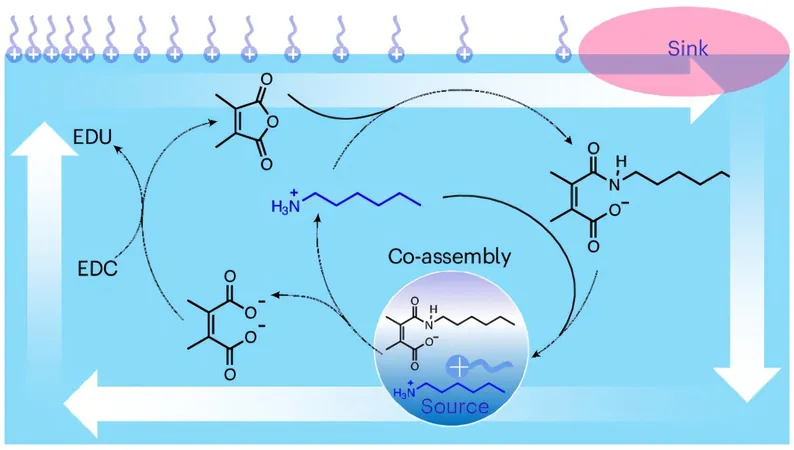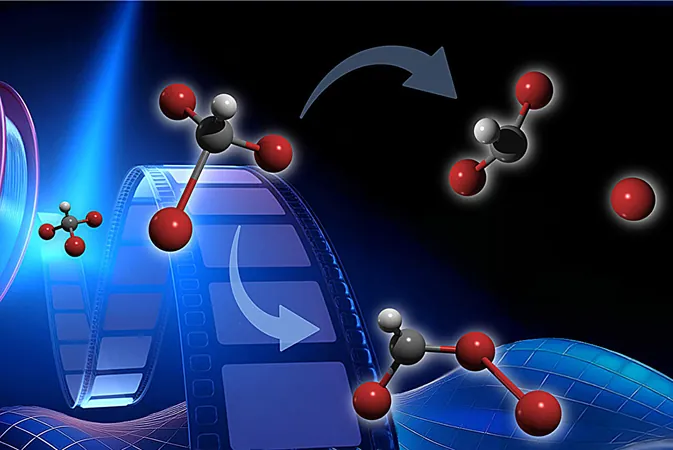
Revolutionary Breakthrough: Chemists Create Active Droplet System That Mimics Life!
2024-11-14
Author: Olivia
Groundbreaking Study Unveiled
In a groundbreaking study, researchers have unveiled a novel droplet system that showcases chemotactic movement, reminiscent of biological organisms. This advancement, centered around dissipative chemical processes, has sparked a flurry of excitement in the field, given its potential applications in designing lifelike materials and systems.
Understanding Dissipative Chemical Processes
Dissipative chemical processes are remarkable because they transform energy from one form to another, enabling systems to operate far from equilibrium. Despite the excitement, creating mechanical functions through dissipative self-assembly akin to biological structures like microtubules has proven to be a formidable challenge—until now.
The Research Team and Their Findings
Published in *Nature Chemistry*, the study led by Prof. Liu Kai from the Shenzhen Institutes of Advanced Technology (SIAT), in collaboration with Prof. Sijbren Otto from the University of Groningen, outlines the development of active droplets that exhibit the capacity for movement toward chemical stimuli. This droplet system is not just an experiment; it potentially paves the way for advancements in soft robotics and micro-nano motors.
The Creation of Active Droplets
The research team crafted these active droplets by utilizing a sophisticated dissipative reaction network. This involved mixing maleic anhydride with octylamine in an aqueous solution to form a dynamic amide bond, which intriguingly could be hydrolyzed under acidic conditions. To drive the continuous formation of the amide from diacid waste and octylamine, carbodiimide acted as a secondary fuel molecule, initiating a dissipative cycle.
Mechanism of Droplet Movement
By harnessing intermolecular electrostatic and hydrophobic interactions, the amide product and octylamine co-assembled into droplets. The addition of specific chemical fuels allowed researchers to fine-tune this self-assembly, resulting in droplets that could transiently grow in size.
Droplet Behavior and Implications
What sets these droplets apart is their ability to move! When oleic acid was introduced to the droplet solution, the droplets instinctively migrated towards the oleic acid. This captivating movement is attributed to the coupling of the dissipative self-assembly process with the Marangoni effect—a phenomenon where surface tension differences drive the flow of liquid. Remarkably, the speed and duration of their movement were easily adjustable.
Insights from the Study
At a molecular level, chemical fuels facilitate the formation of amide bonds, but the magic happens on a nanoscale with the creation of high-energy active droplets, enabling directed movement at a macroscopic level. This creates a captivating picture of how simple chemical interactions mimic life-like behavior.
Future Applications and Perspectives
"The implications of our study are profound," emphasized Prof. Liu. "High-energy dissipative assemblies could serve as innovative energy converters. This may revolutionize the development of active materials, enhancing technologies in micro-motors, soft robotics, and non-equilibrium patterns."
Furthermore, this droplet system stands as a promising model for primitive cells, capable of exhibiting complex collective behaviors, thus offering invaluable insights into the origins of life and the mechanisms that govern biological systems.
Conclusion
This fascinating research not only opens new doors for materials science but also lays the groundwork for future inquiries into synthetic lifeforms. **Could we be on the brink of creating artificial life soon? Stay tuned!**









 Brasil (PT)
Brasil (PT)
 Canada (EN)
Canada (EN)
 Chile (ES)
Chile (ES)
 España (ES)
España (ES)
 France (FR)
France (FR)
 Hong Kong (EN)
Hong Kong (EN)
 Italia (IT)
Italia (IT)
 日本 (JA)
日本 (JA)
 Magyarország (HU)
Magyarország (HU)
 Norge (NO)
Norge (NO)
 Polska (PL)
Polska (PL)
 Schweiz (DE)
Schweiz (DE)
 Singapore (EN)
Singapore (EN)
 Sverige (SV)
Sverige (SV)
 Suomi (FI)
Suomi (FI)
 Türkiye (TR)
Türkiye (TR)